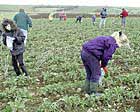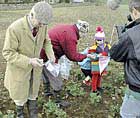

- [field walking]
![]()
field walking
 |
field walking amongst the swedes at Castle Farm |
 |
the Knights go field walking |
Field walking (also known as ground or pedestrian survey) does not require any specialised equipment -- just the eyes and feet of the walker and his or her expertise in identifying any remains that may turn up. An area of a site or potential site is divided into a grid. Field walkers then move slowly through their assigned parts of the grid, picking up everything of interest from the surface -- for instance, pottery sherds, beads, bits of glass, pieces of bone.
These finds will tell the archaeologist a number of things. Remains of various ages may indicate that the site was occupied at different times and, if the remains are from different cultures, by different types of societies. If the density of finds decreases or they simply disappear, this can be a clue to the location of the site's boundaries.
The accuracy of field walking can be affected by the state of the land. Ploughing can bring older finds erratically to the surface. Heavily forested areas are almost impossible to survey in this way because the surface simply isn't visible. Erosion of steep terrains can lead to finds being buried much deeper than they should be or to finds being washed away from their point of origin. And if a site has been occupied by a number of societies over time, it can be very difficult to discover evidence of the earlier ones among the greater number of finds from the later ones.